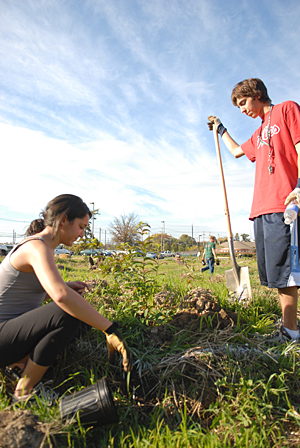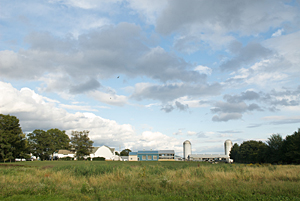ADVERTISEMENT
- Rozovsky wins prestigious NSF Early Career Award
- UD students meet alumni, experience 'closing bell' at NYSE
- Newark Police seek assistance in identifying suspects in robbery
- Rivlin says bipartisan budget action, stronger budget rules key to reversing debt
- Stink bugs shouldn't pose problem until late summer
- Gao to honor Placido Domingo in Washington performance
- Adopt-A-Highway project keeps Lewes road clean
- WVUD's Radiothon fundraiser runs April 1-10
- W.D. Snodgrass Symposium to honor Pulitzer winner
- New guide helps cancer patients manage symptoms
- UD in the News, March 25, 2011
- For the Record, March 25, 2011
- Public opinion expert discusses world views of U.S. in Global Agenda series
- Congressional delegation, dean laud Center for Community Research and Service program
- Center for Political Communication sets symposium on politics, entertainment
- Students work to raise funds, awareness of domestic violence
- Equestrian team wins regional championship in Western riding
- Markell, Harker stress importance of agriculture to Delaware's economy
- Carol A. Ammon MBA Case Competition winners announced
- Prof presents blood-clotting studies at Gordon Research Conference
- Sexual Assault Awareness Month events, programs announced
- Stay connected with Sea Grant, CEOE e-newsletter
- A message to UD regarding the tragedy in Japan
- More News >>
- March 31-May 14: REP stages Neil Simon's 'The Good Doctor'
- April 2: Newark plans annual 'wine and dine'
- April 5: Expert perspective on U.S. health care
- April 5: Comedian Ace Guillen to visit Scrounge
- April 6, May 4: School of Nursing sponsors research lecture series
- April 6-May 4: Confucius Institute presents Chinese Film Series on Wednesdays
- April 6: IPCC's Pachauri to discuss sustainable development in DENIN Dialogue Series
- April 7: 'WVUDstock' radiothon concert announced
- April 8: English Language Institute presents 'Arts in Translation'
- April 9: Green and Healthy Living Expo planned at The Bob
- April 9: Center for Political Communication to host Onion editor
- April 10: Alumni Easter Egg-stravaganza planned
- April 11: CDS session to focus on visual assistive technologies
- April 12: T.J. Stiles to speak at UDLA annual dinner
- April 15, 16: Annual UD push lawnmower tune-up scheduled
- April 15, 16: Master Players series presents iMusic 4, China Magpie
- April 15, 16: Delaware Symphony, UD chorus to perform Mahler work
- April 18: Former NFL Coach Bill Cowher featured in UD Speaks
- April 21-24: Sesame Street Live brings Elmo and friends to The Bob
- April 30: Save the date for Ag Day 2011 at UD
- April 30: Symposium to consider 'Frontiers at the Chemistry-Biology Interface'
- April 30-May 1: Relay for Life set at Delaware Field House
- May 4: Delaware Membrane Protein Symposium announced
- May 5: Northwestern University's Leon Keer to deliver Kerr lecture
- May 7: Women's volleyball team to host second annual Spring Fling
- Through May 3: SPPA announces speakers for 10th annual lecture series
- Through May 4: Global Agenda sees U.S. through others' eyes; World Bank president to speak
- Through May 4: 'Research on Race, Ethnicity, Culture' topic of series
- Through May 9: Black American Studies announces lecture series
- Through May 11: 'Challenges in Jewish Culture' lecture series announced
- Through May 11: Area Studies research featured in speaker series
- Through June 5: 'Andy Warhol: Behind the Camera' on view in Old College Gallery
- Through July 15: 'Bodyscapes' on view at Mechanical Hall Gallery
- More What's Happening >>
- UD calendar >>
- Middle States evaluation team on campus April 5
- Phipps named HR Liaison of the Quarter
- Senior wins iPad for participating in assessment study
- April 19: Procurement Services schedules information sessions
- UD Bookstore announces spring break hours
- HealthyU Wellness Program encourages employees to 'Step into Spring'
- April 8-29: Faculty roundtable series considers student engagement
- GRE is changing; learn more at April 15 info session
- April 30: UD Evening with Blue Rocks set for employees
- Morris Library to be open 24/7 during final exams
- More Campus FYI >>
11:45 a.m., May 18, 2010----Several times a week, Chad Nelson begins his workday with a trek through a wetland near his Townsend Hall office on the University of Delaware's Newark campus. With spring in full swing, he enjoys the sight of the butterflies, migratory songbirds, mallard ducks and their ducklings, frogs and tadpoles that make the wetland their warm-weather home.
Later this summer Nelson, an assistant professor of landscape design in the College of Agriculture and Natural Resources, will be on the look out for dragonflies. And even in winter, he says the wetland teems with life, with such species as glossy ibis and over-wintering songbirds.
Two years ago, about the only animal life this two-acre site supported were dairy cows and migrating Canada geese.
Jenny McDermott, facilities manager for the college, spearheaded the effort to convert a poorly draining cow pasture into a wetland.
Her go-to man on the project was Tom Barthelmeh, who is a wetlands restoration expert with the state's Department of Natural Resources and Environmental Control (DNREC).
“This project had a lot of challenges and Tom's help was integral,” says McDermott. “Our goal in creating this wetland was not only to provide wildlife habitat but to improve water quality in the White Clay watershed.”
Once it is fully operational, the wetland will reduce runoff to Cool Run, which is a tributary of White Clay Creek. And that's just one of the ways it will help the watershed.
The University's farm and main campus are where Cool Run starts, the headwaters of the stream, and thus are a critical area for influencing environmental quality.
“Wetlands, especially in this area, do a lot of good things for a watershed,” explains McDermott. “By taking the pressure off the rate and volume of water that flows into a stream, wetlands reduce problems caused by stormwater runoff downstream.”
From a wildlife habitat perspective, the wetland gets high marks from Doug Tallamy, chairperson of UD's Department of Entomology and Wildlife Ecology.
“The new wetlands will raise the carrying capacity of the UD Farm for decades,” says Tallamy. “The wet areas churn out insects that develop on detritus. These support swifts, martins, swallows and bats. Wading birds eat the aquatic insects and frogs in the wet areas. The wetland also provides habitats for breeding birds. It's very productive. And none of this was happening when it was a cow pasture.”
Barthelmeh says he enjoyed the project, especially because it gave him the opportunity to mentor students. UD undergraduate and graduate students were involved in every aspect of the project, from site design and installation to the two rounds of planting that occurred, most recently last October.
Nelson spearheaded plant design with plenty of assistance from his students. Almost 2,000 trees, shrubs and perennial seed plugs have been planted at the site, ranging from blue flag iris, which provides purple-blue spring blooms; buttonbush, which blooms in summer; bald cypress, with its brilliant rusty orange fall foliage; and winterberry holly, known for its red berries in winter.
A whopping 90 percent of the first year's planting survived despite dry planting conditions and some damage by waterfowl.
“I was concerned last year because a lot of Canada geese were browsing the wetland but most of the damage wasn't significant since it was confined to the stalks and not the roots,” says Nelson.
The wetland is one component of a comprehensive plan to make the UD Farm a model of sustainable, environmentally friendly agriculture.
McDermott is now busy overseeing other conservation projects. Additional channel and wetland restoration will take place along the entire length of the Cool Run tributary running through the farm. A stormwater retrofit will address building and parking lot runoff that flows into Cool Run.
“These restoration efforts wouldn't be possible without a lot of partners within the university, from DNREC and from the New Castle Conservation District,” says McDermott. “Grant funding from several DNREC departments and from the University's alumni-supported Sustainability Fund have been matched by funding from our college to not only implement environmental protection but to provide a teaching opportunity for students and a demonstration of watershed protection.”
The UD wetland has been utilized as an outdoor classroom by landscape design, landscape construction, ornithology, wildlife management and wildlife ecology students. And it serves a public education function, as well, especially now that it has become a part of the UD Botanic Gardens.
“We offered wetland tours on Earth Day and Ag Day and the public is welcome to take self-guided tours any day from dawn to dusk,” says McDermott. “Wetlands are sometimes seen as a 'no man's land.' We want people to appreciate the positive impact they can have on water quality and the diversity of wildlife they support. Wetlands are incredibly important.”
To learn more, visitors can take a self-guided tour of the UD Botanic Gardens wetland from dawn to dusk daily. The wetland is located on UD's Farm off Route 896 in Newark, near the Girl Scouts building.
Article by Margo McDonough
Photos by Danielle Quigley




